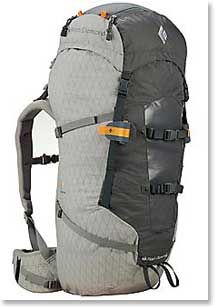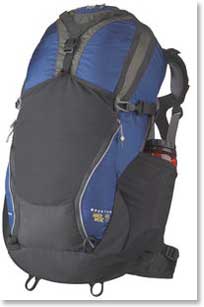
Expedition Gear Series
Choosing the Right Backpack
By Tracy Jacobson
The popularity and demand for backpacks these days adds to a vast selection from many different suppliers. It is not as simple as small, medium or large. We are in the times of multiple coffee and beer choices as well as customizing your gear to fit your body.


Left: Black Diamond Quantum 45L or 55L
Right: Mountain Hardwear Supernatural 40L
Types of backpacks — top loader or side access:
Top loader: Personal preference could include a top-loading pack, as it has less zippers. Top-loading, single-compartment packs are always good for BAI trips because at times your day pack will be loaded onto planes, vehicles, or handed off to guides who are assisting you. It is very important not to have items dangling off your pack when climbing or hiking on mountain trails.
One disadvantage to a top loader is the fact that you have access to the contents only from the top. When you need to adjust your clothing and gear (as can happen multiple times in the mountains) you may have to pack and re-pack every time, which can become very tiresome.
Side access: There are more packs available now with side access than top loaders. When choosing a pack with zippers, you want to look for quality. There is nothing like getting a cheap pack and having your zipper stuck for the duration of the trip.
Extra pockets and compartments: The more compartments you have, the more chances that you will forget which pocket you put your camera in and miss that Kodak moment. A couple pockets (on top and side) are handy to have for sunscreen, camera, journal, etc. For trekking, keep it simple, and stay away from the extra strings and gadgets on the outside (exception: for climbing, when applicable you will need gear loops for an ice axe).
A chest strap: Ask a staff member in your local outdoor shop how to adjust the strap properly. It should sit just below your shoulders across your chest.
Rain cover: Highly recommended. This keeps the dust and moisture out of your pack. Some packs come with attached covers (great for easy access and helps to prevent losing your cover).
Size: Berg Adventures will give you the recommended pack size (cubic litres) for your specific trip. It is not recommended to go smaller; otherwise you will be hanging half of your daywear on the outside of your pack. Going much bigger, you could possibly join the porter team.
Getting the perfect fit:
The best way to get the right fit for your body is to head down to your nearest outdoor shop. Plan to spend some time and try on a bunch of packs. Get the staff member to put some weight into the pack and carry it around the store for a few minutes.
Important considerations for the perfect fit:
- Female or male
- Height and torso size
- Adjustable straps: It is important your pack is adjusted to your body. It should be a snug fit and once loaded should not be sitting on your shoulders or pulling you backwards.
- Waist belt: It is very important to have a padded waist belt. Your hips will be carrying most of the weight and having sore hips would not make for a fun trip. MAKE SURE the waist belt is on your hips not around your stomach.

